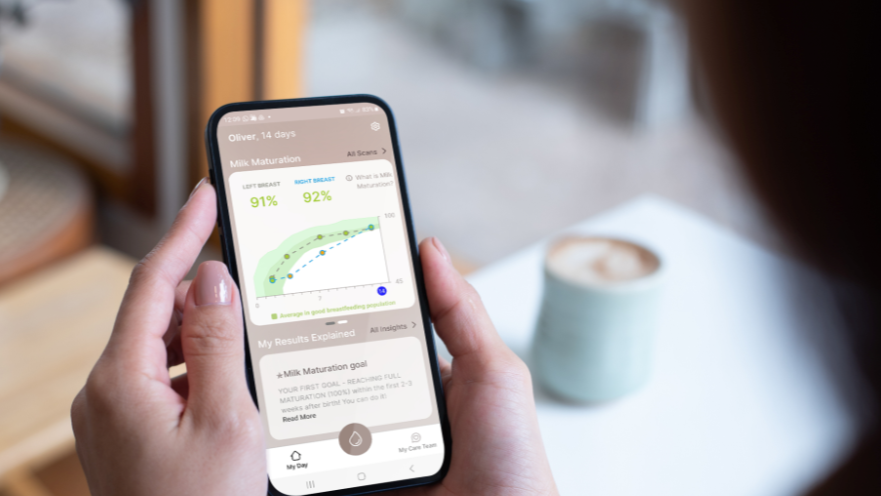A novel parameter for tracking secretory activation progress
Milk maturation indicator and Insights
Milk maturation is NOT a medical term, It is a measure developed by MyMilk professional team to assist you and your lactation professional to track secretory activation progress and better understand your day to day routine breastfeeding establishment.
Milk maturation % reflects secretory activation progress and breastfeeding establishment dynamics, not milk "quality" or sufficiency.
Milk maturation is NOT a medical term, but rather a measure developed by MyMilk professional team to assist you and your lactation professional to better understand your day to day routine breastfeeding progress.
This measurement cannot diagnose adequacy or inadequacy of baby feeding, and does NOT imply anything about milk sample nutritional quality.
This measurement does not substitute direct breastfeeding evaluation by a caregiver.
While it does not diagnose feeding adequacy, it generally correlates with baby weight gain and breastfeeding exclusivity. The lower the maturation, the less advanced a mother is in her supply establishment progress.
For each milk sample reading, MyLee computes a numeric milk maturation parameter from 0% (colostrum) to 100% (fully mature milk).
Milk maturation % is computed by measuring the electrical resistance of individual milk sample, and placing it on the range determined by MyMilk based on a propriety dataset generated by measurements from thousands of milk samples collected throughout days 1-150 after birth, from hundreds of mothers, to full term, healthy, singleton babies.
The full range is 5%-120%.
5% corresponds to earliest milk samples, whereas 100% corresponds to advanced exclusive breastfeeding beyond 30 days after birth.
The index is color-coded relative to MyMilk benchmarks for the specific postpartum day, based on MyMilk’s reference dataset. The color of the index indicates whether the sample is above (Green) or below (Orange) the 15th percentile of samples scanned by MyMilk systems, from mothers in predominant breastfeeding in comparable day ranges.
Color cannot diagnose adequacy or inadequacy of baby feeding.
The system estimates the day postpartum the sample aligns with compared to MyMilk’s data. This helps identify if the milk is progressing, delayed, or advanced in maturation, and demonstrate the extent of a delay.
Day from birth prediction generated by estimating What day or day-range after birth does your best recent sample corresponds to (“behaves like”), when compared to samples from other mothers in predominant breastfeeding. This can help you understand how similar or different your sample maturation % is compared to other mothers’ in MyMilk sample data-set at any specific time after birth.
Milk maturation % derived insights, and personal goals are developed by MyMilk professional team.
Milk maturation % compares breasts and tracks changes over time, providing insights on supply, breast imbalance or restricted milk flow, which could signal the need for improved milk removal. This indication is not intended and cannot serve to diagnose any medical condition in the breast.
Haramati S, Firsow A, Navarro D, Shechter R
Novel At-Home Mother’s Milk Conductivity Sensing Technology as an Identification System of Delay in Milk Secretory Activation Progress and Early Breastfeeding Problems: Feasibility Assessment
JMIR Pediatr Parent 2023;6:e43837
URL: https://pediatrics.jmir.org/2023/1/e43837
DOI: 10.2196/43837
Haramati, S., Firsow, A., Navarro, D.A.et al. A handheld milk conductivity sensing device (Mylee) for measuring secretory activation progress in lactating women: a device validation study.
BMC Pregnancy Childbirth 25, 60 (2025).
https://doi.org/10.1186/s12884-025-07141-x
Curated Tips, Insights and Content
The content in the Mylee App was adapted by MyMilk professional team, according to information curated from clinical protocols, governmental guidelines and scientific peer-reviewed studies as listed:
Baby weight for age chart are derived from WHO child growth standards, based on WHO weight-for-age percentiles tables for 13 weeks, for boys and girls.
WHO Multicentre Growth Reference Study Group. WHO Child Growth Standards: Length/height-for-age, weight-for-age, weight-for-length, weight-for-height and body mass index-for-age: Methods and development. Geneva: World Health Organization, 2006.
Average daily weight gain is calculated by subtracting the most recent logged baby weight from most recent previously logged baby weight, and dividing the result by the number of days between the two weighing dates. Weekly weight gain is calculated by multiply daily weight gain by 7.
Weight gain below 5th percentile for each age group is presented in red, color is for purpose of attention and is not intended to diagnose adequate or inadequate weight gain (WHO child growth standards; weight velocity (g/d) tables for boys and girls).
WHO Multicentre Growth Reference Study Group. WHO Child Growth Standards: Growth velocity based on weight, length and head circumference: Methods and development. Geneva: World Health Organization, 2009
Breastfeeding Efficiency Quiz is based on the LATCH score, a commonly used breastfeeding charting system and documentation tool for gathering information and assessing individual breastfeeding sessions for evaluating effectiveness of early breast-feeding and subsequent evaluation for charting progress.
System includes standardized questions and numerical score adapted from Jensen et al 1994. LATCH scores identify areas of needed intervention and help with their reporting in a straightforward way. Self-assessment of LATCH by a mother, does not substitute a face to face latch score by a lactation professional.
Jensen D, Wallace S, Kelsay P. LATCH: a breastfeeding charting system and documentation tool. J Obstet Gynecol Neonatal Nurs. 1994 Jan; Principels & Practice 23(1):27-32.
Breastfeeding confidence quiz is based on Mother Infant Breastfeeding Satisfaction Scale (MIBSS) sub-scale for H & H lactation scale.
Humenick, S. S., Hill, P. D., & Wilhelm, S. (1997). Postnatal factors encouraging sustained breastfeeding among primiparas and multiparas. The Journal of Perinatal Education, 6(3), 33–45.
Hill, P. D., & Humenick, S. S. (1996). Development of the H & H lactation scale. Nursing Research, 45(3), 136–140
Number of wet and dirty Diapers are based on UNICEF Breastfeeding assessment tool for assessing baby’s breastfeeding (UNICEF UK Baby Friendly Initiative).
Implementing Baby Friendly standards resources– Breastfeeding Assessment Tools, The baby friendly initiative, UNICEF UK, 2018
Early Breastfeeding practices e.g. hand expression, skin to skin, artificial teats, pacifier and bottles introduction, are adapted based on UNICEF UK Baby Friendly Initiative standards, NHS UK pregnancy and baby guide media for mothers issued Breastfeeding Problems, and ABM clinical Protocols #2, #7, #14 published by the Academy of Breastfeeding Medicine.
UNICEF UK BABY FRIENDLY INITIATIVE: GUIDE TO THE STANDARDS – SECOND EDITION, The baby friendly initiative, UNICEF UK, 2017.
NHS UK . Your pregnancy and baby guide – Breastfeeding Problems. https://www.nhs.uk/conditions/pregnancy-and-baby/problems-breastfeeding/
Evans A, et al. The Academy of Breastfeeding Medicine. ABM clinical Protocol 2: Guidelines for Hospital Discharge of the Breastfeeding Term Newborn and Mother: ‘‘The Going Home Protocol,’’ . Breastfeeding Medicine, volume 9, N1, 2014.
Herna´ndez-Aguilar M, et al. The Academy of Breastfeeding Medicine. ABM clinical Protocol 7: Model Maternity Policy Supportive of Breastfeeding. Breastfeeding Medicine, volume 13, N9, 2018
Grawey A, et al. The Academy of Breastfeeding Medicine. ABM clinical Protocol 14: Breastfeeding-Friendly Physician’s Office: Optimizing Care for Infants and Children. Breastfeeding Medicine, volume 8, N2, 2013
Breastfeeding conditions insights are in-line with NHS UK pregnancy and baby guide media for mothers issued Breastfeeding Problems, ABM clinical Protocols #4 mastitis, #26 persistent pain with breastfeeding, #32 the management of hyperlactation, #24 allergic proctocolitis , published by the Academy of Breastfeeding Medicine.
NHS-UK. Your pregnancy and Baby guide, Breastfeeding Problems. https://www.nhs.uk/conditions/pregnancy-and-baby/problems-breastfeeding/
Amir L.A, et al. The Academy of Breastfeeding Medicine Protocol Committee. ABM clinical Protocol 4: Mastitis. Breastfeeding Medicine, volume 9, N5, 2014
Berens P, et al. The Academy of Breastfeeding Medicine. ABM clinical Protocol #26: Persistent Pain with Breastfeeding. Breastfeeding Medicine, volume 11, N2, 2016
Johnson H.M, et al. The Academy of Breastfeeding Medicine. ABM clinical Protocol # 32: Management of Hyperlactation. Breastfeeding Medicine, volume 15, N3, 2020
The Academy of Breastfeeding Medicine. ABM clinical Protocol # 24: Allergic Proctocolitis in the Exclusively Breastfed Infant. Breastfeeding Medicine, volume 6, N6, 2011
Breastfeeding hunger cue signs factsheet and Hand expression technique factsheets are external links to materials developed by Royal Brisbane and Women’s Hospital, Metro North Hospital and Health Service.
Breastfeeding Educational Videos includes external links to material developed by third parties as displayed on the video.
First droplets by Dr. Jane Morton, MD. Breastfeeding educational videos includes materials developed by Dr. Jane Morton, MD, Cl. Adj. Professor of Pediatrics Emerita Stanford University School of Medicine, and produced for educational purpose only. These materials were adopted by Lucile Packard Children’s hospital (Stanford children’s health) for demonstration of evaluated techniques to enable successful breastfeeding for mother and child. For more information on the video visit the non-for profit website www.firstdroplets.com.
Love.and.milkk by Chelsea Anderson, CLC. Breastfeeding and pumping accessible explanatory videos generated by Chelsea Anderson, a certified lactation counsellor under the independent brand of love.and.milkk.
This easy-to-use self-administered patient questionnaire is used as a screening tool and severity measure for generalised anxiety disorder (GAD).
The GAD-7 score is calculated by assigning scores of 0, 1, 2, and 3, to the response categories of ‘not at all’, ‘several days’, ‘more than half the days’, and ‘nearly every day’, respectively, and adding together the scores for the seven questions.
Scores of 5, 10, and 15 are taken as the cut-off points for mild, moderate and severe anxiety, respectively. When used as a screening tool, further evaluation is recommended when the score is 10 or greater.
Using the threshold score of 10, the GAD-7 has a sensitivity of 89% and a specificity of 82% for GAD. It is moderately good at screening three other common anxiety disorders – panic disorder (sensitivity 74%, specificity 81%), social anxiety disorder (sensitivity 72%, specificity 80%) and post-traumatic stress disorder (sensitivity 66%, specificity 81%).
Please note that while great care has been taken with the development of this self-test, it is not intended to be a substitute for professional clinical advice. The result is indicative only. If you have scored above the threshold on this scale, see your doctor or a mental health practitioner, such as a counsellor, psychotherapist or psychologist.
Spitzer RL, Kroenke K, Williams JB, et al; A brief measure for assessing generalized anxiety disorder: the GAD-7. Arch Intern Med. 2006 May 22;166(10):1092-7.
GAD-7 Royalty Free by Pfizer Inc.
SYSTEM IS NOT INTENDED TO DIAGNOSE OR TREAT ANY MEDICAL CONDITION.
The system is intended for informational purposes, to assist you to track and manage your breastfeeding routine practice. System cannot determine or diagnose adequacy or inadequacy of baby feeding.
Use of the system cannot substitute direct breastfeeding evaluation, or direct advice by a caregiver. In any doubt, consult your caregiver.
The system was designed for healthy mother to a healthy term baby, and should not be used for other circumstances.
For any questions contact us via the App at My Support Team screen, or via email at: Contact@mylee.life

